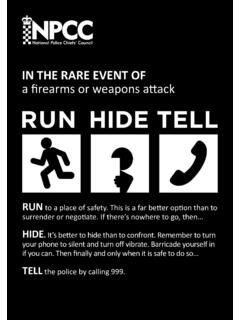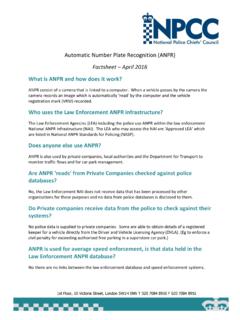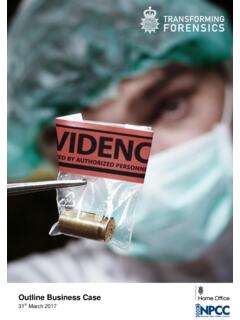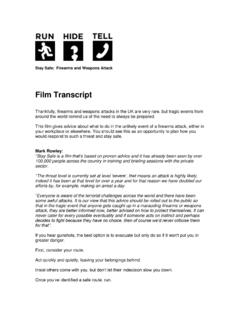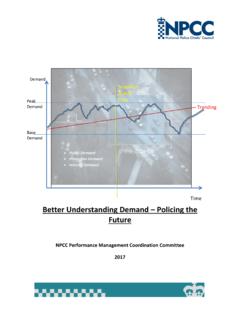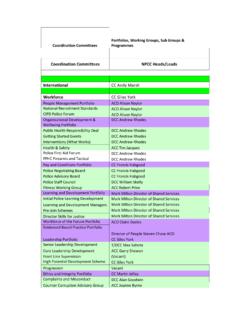Transcription of Gravity matrix (Adult) - National Police Chiefs' Council
1 Gravity matrix (Adult) Two-Tier framework V1 FEBRUARY 2019 Introduction: This matrix is a decision making tool to assist in deciding if an adult offender can be dealt with by the use of an Out of Court disposal. It is based on the offence committed, taking into account any aggravating or mitigating factors, as well as the harm that the offender may present based on their previous offending history. In addition where the victim s views are obtainable, these should be taken into account. In compliance to the nationally agreed Out of Court Disposal Strategy, the matrix is based on two possible Out of Court options, namely: Conditional Cautions and Community Resolutions.
2 The final outcome score should only be decided once the appropriate offence has been selected, consideration of aggravating or mitigating factors, and key factors checklist completed. For those forces who have not yet moved to the two tier framework, the original Gravity matrix should be referred to. Feedback or amendments should be directed to the Out of Courts Disposal portfolio at: Steps: Section 1 Identify final outcome scores and possible actions Follow the key factors checklist Consult with the victim Record your rationale Section 2 Consider general aggravating / mitigating factors (including those for specific offence types Domestic Abuse, Hate crime & Road Traffic) Section 3 Specific considerations apply if you are dealing with a type of offence listed in this section (Domestic abuse, Hate crime , Knife crime , Foreign National Offenders, Football offences & Road Traffic)
3 This section also provides further guidance on relevant legislation and charging decisions Section 4 List of offences (alphabetical - To keyword search: Ctrl + F) 1 Contents: Section 1 Outcomes Outcome scores & actions Decision making guidance Key factors checklist Section 2 - Aggravating / Mitigating factors General aggravating and mitigating factors for all offences Domestic Abuse specific aggravating and mitigating factors Hate crime specific aggravating and mitigating factors Traffic specific aggravating and mitigating factors Factors for Emergency Workers Act 2018 Section 3 Specific offence considerations & charging decisions Domestic Abuse Hate crime
4 Knives & offensive weapons Foreign National Offenders Football Offences Charging Decisions vs Out of Court Disposals Traffic Offences Section 4 List of offences (bookmarks for commonly used offences for all others, keyword Search using Ctrl F) Assaults Burglary Communications Criminal damage Cruelty Domestic abuse Drugs Drunkenness Firearms Harbouring Harassment & Stalking Interference with the court of justice Obstruction Offensive weapons Public order Road traffic Road traffic documents Sexual offences Sporting events Theft & Fraud Wasting Police time Appendix A - Traffic Offences 2 Section 1 Outcome scores and actions Score Action 4 Always Charge A conditional caution would not usually be appropriate for a score of 4 however it could be
5 Considered in exceptional circumstances relating to the offence, the offender or the victim where it can be justified (see notes below) 3 Normally Charge Consider a conditional caution if the circumstances fit and you as the decision maker can justify this (see notes below) A community resolution would rarely be suitable, but could be applied if the decision maker can fully justify this outcome 2 Normally conditional caution (consider charge if justified or community resolution if appropriate) 1 Community Resolution (consider conditional caution if justified) Notes Conditional Cautions.
6 If the offence is indictable only (IO) it requires CPS advice If it is one of the offences deemed exceptional circumstances in Annex A of the Director s Guidance on Adult Conditional Cautions it requires an Inspectors authority) 3 Decision making guidance The offence tables in section 4 classify most common offences on a scale of 1 (low Gravity ) up to 4 (high Gravity ) based on the seriousness of the individual offence. They are based on charging standards not Home Office crime recording standards. Please note: Factors which can make an offence more serious are shown as aggravating (+) while mitigating factors (making an offence less serious) are shown as (-) Scores should only be upgraded or downgraded by ONE POINT irrespective of the number of factors present (they may balance each other out).
7 These factors must be recorded in the decision record. Offences Not Shown in the matrix : It is not possible to include all offences within this document a general rule is summary only offences are a 1 or 2, either way offences are a 2 or 3, indictable only offences are a 4. (Please refer to the Police National Legal Database for a full list of all offences) Key factors checklist In deciding whether to charge, give a community resolution or conditional caution the following should be considered (and included in the decision making log): Do they admit the offence?
8 The seriousness of the offence - is it a proportionate response? Any mitigating or aggravating factors? The previous offending history of the offender including the effectiveness and compliance with any previous OOCD please note: 1. a second conditional caution for the same or similar offence is generally not appropriate within 2 years unless it is in exceptional circumstances 2. a second community resolution for the same or similar offence is not generally appropriate within 12 months unless it is in exceptional circumstances.
9 Where the evidential aspect of the Full Code Test is met, would the public interest be properly served by issuing a Community Resolution or Conditional Caution? Does the disposal adequately address, support and reduce the risk of reoffending? 4 Are there appropriate intervention options available that will address the needs and underlying behaviour/s of the offender? (Force specific) Views of the victim must be sought wherever possible to establish*: 1. their view about the offence 2. the nature and extent of any harm or loss 3.
10 The significance relative to the victim s circumstances 4. their views on the outcome and the conditions including considerations for compensation, Restorative Justice, making right any damage 5. The victims view should be taken into account but the final decision rests with the Decision Maker (*Sections 102 & 103 Anti-Social Behaviour, crime and Policing Act 2014) (Decision makers should ensure their rationale is fully recorded and in a format in compliance with their force policy) 5 Section 2 GENERAL MITIGATING AND AGGRAVATING FACTORS FOR ALL OFFENCES.

